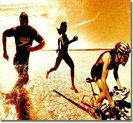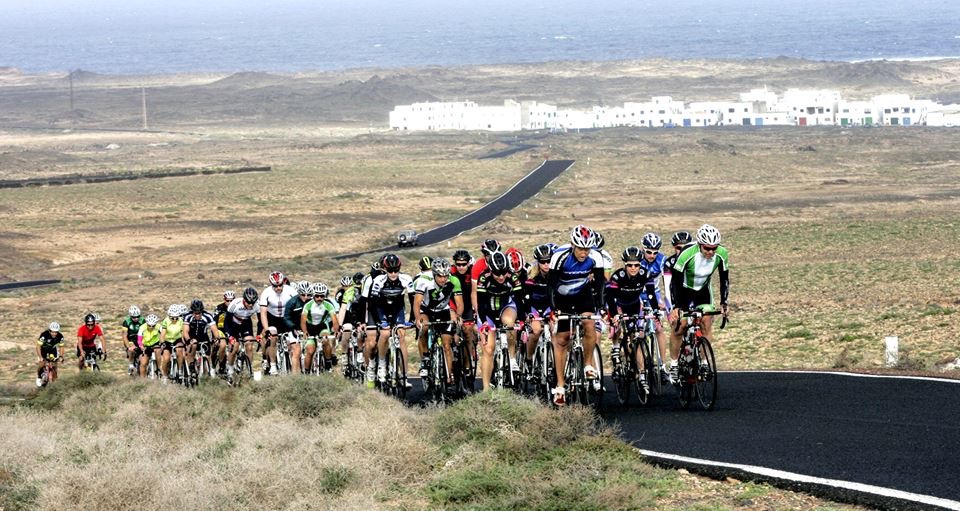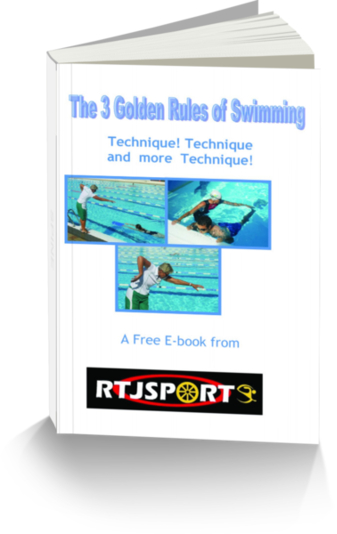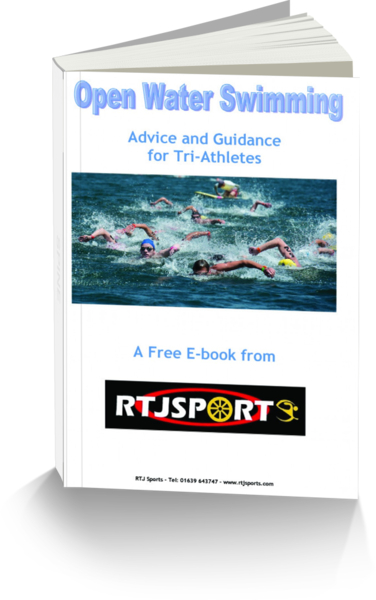Run
Many athletes aspiring to become triathletes come into the sport from either swimming, cycling or running backgrounds. Most people have run at sometime in their lives.
Of the three disciplines, running is the least complicated, but the sensation of putting one foot in front of the other after having swam and then cycled for over an hour only remotely resembles the smooth flowing movement experienced in a single running event.
The adjustment of the different muscle groups used, from bike to run are not your normal warm up for a 10km run.
The fatigue felt during the transition from bike to run can be very severe. The ability to overcome that fatigue and to run fast and efficiently can be a major factor in successfully completing an event.
There are no short cuts to becoming a good triathlon runner.
Technique, speed, strength and flexibility training, together with an awareness of the specific requirements of triathlon running will lead to longer and faster performances.
Speed:
When triathletes with similar levels of aerobic and anaerobic endurance compete against each other into the final discipline, it is normally their basic running speed that decides the outcome. Speed is an essential attribute for any endurance event and it is as important to develop this aspect of fitness, as it is to develop stamina.
Running speed is related to how fast the legs move and how much distance is covered with each stride.
Speed = Stride Length x Stride Rate.
An increase in length of the stride will lead to an increased speed provided the rate of the stride is not slow. Alternatively, an increase in cadence will have the same result, provided the stride length stays constant. This will depend on the athlete’s flexibility, the range of movement in the joints, and strength in the running muscle groups.
Technique:
Running is the most simple of the three disciplines, but it is the only discipline in which the athlete carries their own body weight and remain unprotected by the forces of gravity. These forces are multiplied when we are running and will at some point cause an injury, very few athletes will get away from some sort of niggle, strain, break or inflammation during their lifetime of sport, especially running.
The technique of endurance running is a modification of sprinting. As relaxation and saving energy are so important in triathlon, the action of running has to be more compact in order to eliminate unnecessary expenditure of energy.
As with the arms in swimming there is a recovery phase and a propulsive phase, with the legs in running.
The propulsive phase starts as soon as the foot makes contact with the ground during a running stride. As the foot carries the body weight the hips and trunk pass over the foot, and the hip, knee and ankle stretch out to push the runner forwards.
The recovery phase begins with the foot breaking contact with the ground. The foot is pulled upwards to the backside and the thigh swings forward and through until it is parallel, or nearly parallel to the ground. The lower part of the leg then comes forward as the thigh begins to move downwards. The whole leg then sweeps backwards and downwards until the foot strikes the ground again.
The upper body remains upright or slightly leaning forwards. The arm action is often forgotten, but it should match the leg action, with the left arm coming forward at the same time that the right leg and vice versa, in an equal and opposite reaction. The arm movement should be kept relaxed and rhythmic, moving backwards and forwards in a straight line with hands loosely cupped and the thumb resting on the fingers.
You will feel stiff and tight at sometime during your run – shake your arms out from time to time – drop your elbows and touch your thighs with your thumbs – this helps to loosen tension.
Skills and Running Drills:
Running at a good speed has to be learnt if it is to be done efficiently. Thousands of people may run every day, but running is still a skill that can be improved by attention to detail. A complex movement cannot be improved by running fast, that will only reinforce or exacerbate existing faults.
Drills:
Drills are designed to develop the running action; they were commonly used by sprinters. Over the last decade endurance runners have focused on adopting these running drills as part of their training plan. To become faster they need to explore all possibilities.
Good execution of drills requires good co-ordination and balance. The action will have to be learnt individually by working through each one separately in slow motion.
Drills Isolate and concentrate on only one aspect of running at a time and are carried out for very short distances, usually 40 -100m.
Some fundamental learning principles have to be observed, before embarking on adding new complicated drills into your schedule.
Typical Drills:
[Here are few to get you started]
High Knees: This drill exaggerates the knee lift action of the running stride. Keeping a normal upright posture, and going up on the forefoot, bring the knee up to the height of your hips. Keep the arms bent at 90° or slightly less and synchronise them with your legs [opposite arm, opposite leg]. The rate of this drill should be as fast as possible [faster than your running stride] while maintaining correct form. Try not to bend forward to watch your feet or lean back. Progressively incorporate any drill into your training session. Start with 4 sets of 30 steps and then build up to 8-10 sets, keeping the repetitions at 30steps.
Bum Kicks: This drill exaggerates the heel lift action of the running stride. Keeping a normal upright posture, and going up onto the forefoot, simply kick the heel up to your bottom/bum. Again, don’t forget about synchronising your arms and try not to lean forward. Start as above with 4 sets of 30 bum kicks and build up to 8-10 sets with the repetitions remaining at 30.
Bounding: This drill exaggerates the entire running action and slows it down, lifting high between steps and floating between foot-plans.
Strides: These are short intervals of 60-200m, designed to improve your technique and achieve faster leg turnover. Good running technique requires a smoothly flowing forward movement with the correct knee lift and foot-strike.
Improve Leg Turnover:
Leg ‘turnover’ is the term given to the rate of steps you take per minute. The logic behind this is that a higher turnover [or cadence] means shorter ground contact time, less energy loss into the ground and, therefore, greater speed.
Running becomes efficient at around total steps 170-180. Include into your training plan counting your strides for a minute. Aim to get as close to target as possible – I find this helps with my running as the mind-focusing mantra of counting keeps me in the moment.
Mobility:
Strength and mobility play an important part in the length and speed of the stride when running. With a busy training schedule, some aspects- usually mobility – can easily be neglected. Triathletes have an advantage over pure runners as the 3 different sports do give greater mobility. However, it should be remembered that mobility naturally decreases from the late teens unless remedial action is taken. Mobility should be done on every training session during the warm up and warm down [cool down] period.
Good mobility is particularly important in triathlon, as it encourages efficient movement in the last discipline of a race when fatigue is starting to be felt by the competitor. A good level of mobility will reduce energy demands.
When performing stretching exercises you should slowly stretch out as far as possible and then hold that position for a count of 10-20 seconds before slowly relaxing and then repeating. No two athletes will be able to stretch to the same extent, since one person’s flexibility will be greater or less than the other.
Mobility work can be divided into Active Stretch [Athletes stretch their own muscles] and Passive Stretch [When Athletes have a partner to stretch their muscles]. For passive stretching, the partner must be aware of the dangers of forcing a muscle to stretch too far.
Stretch only to the point where you can feel tension in the muscle. Muscles are designed to stretch no more then 1.6 times its length at the most.
Remember to breathe while you are a holding a stretch – We do unconsciously hold our breath.
Some athletes carry a small rope with them, to properly stretch their hamstrings, glutes and quads.
For really tight, even painful muscles seek out a Sports Therapist and have a Sports Massage.
You can Self Massage with a foam roller, massage ball or tennis ball – but it is worthwhile seeking professional advice or someone with experience how to do this properly.
< See Sports Therapy>
Running Shoes:
Running is relatively undemanding when you think how little kit you need!
But! At the top of the list, and of crucial importance, are the shoes in which you run. Thinking of the anatomy of the foot- each foot has 26 bones, 33 joints, 107 ligaments and 19 muscles and tendons.
When all these components work in harmony your feet will carry you anywhere at anytime. To make sure that the foot performs to their best we must take care of them.
Everyone has a different running style, so it is critically important to choose a shoe that suits your personal running style.
There are lots of fashions branded shoes on the market, but not all will suit you! Choosing the wrong type for you can, and will, lead to discomfort, and worst still injury.
How to choose the right shoes:
Research and Technology are constantly moving forward to find that perfect shoe.
When you shop for your first pair, go to a specialist running shop where your gait can be observed. This will help you find the particular shoe that is right to you. Do not make the mistake and buy a pair because they are cheap or for the colour!
Some of the questions you may be asked when you buy your first pair:
• Are you a neutral runner
• Over-pronator
• Supinator
Simple test that you can do before shopping- Next time you have a shower or bath – plant a wet foot on an A4 sheet of paper and take a look at the imprint it makes. This will give you a pretty good idea of your foot plant and shape.
If you have high arches you’ll see a very narrow imprint under the mid-foot.
If you have flat feet you will see a thick imprint connecting the heel and forefoot.
A normal foot will reveal a narrower imprint connecting the heel and forefoot [but not as narrow as a high arch].
However, this only describes your foot type – the next step is to check and have a gait analysis done. [How your foot reacts as you land and push off with each stride].
Endurance athletes such as triathletes should look for support shoes – check when buying if the shoe types you are purchasing are suitable to your weight.
Some triathletes train in a support heavier shoe but race sprint in racing lighter pair. You must train and adapt to the different types.
Having the right shoes for your foot type and gait, the terrain on which you run and, importantly, getting them correctly fitted will make the difference between a comfortable and an uncomfortable run.
Or put another way –
Winning your race or losing your Race!









